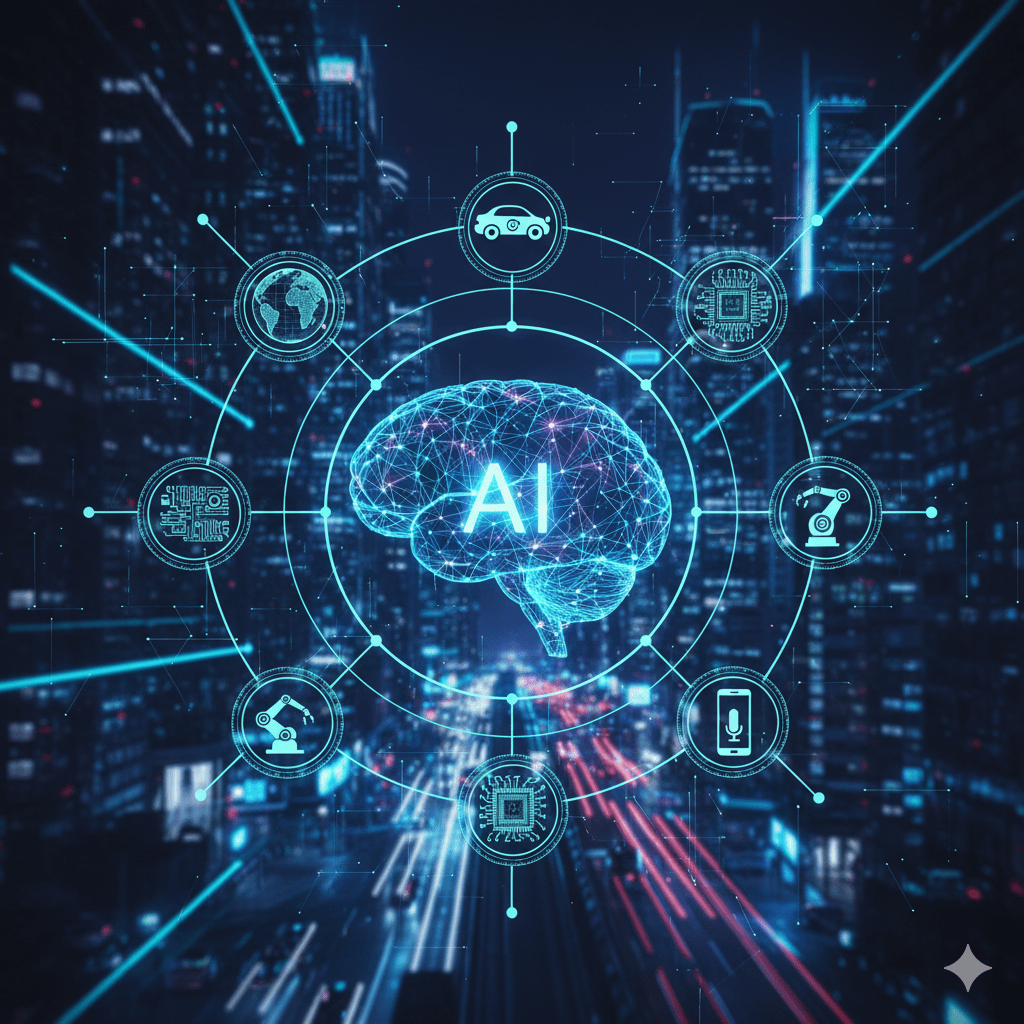
Introduction to Artificial Intelligence: Complete Guide
Artificial Intelligence (AI) has become one of the most transformative technologies of our time. From virtual assistants to autonomous vehicles, AI is revolutionizing how we live, work, and relate to technology.
What is Artificial Intelligence?
Artificial Intelligence refers to the ability of machines to perform tasks that typically require human intelligence. This includes:
- Learning from experience
- Reasoning and problem-solving
- Understanding natural language
- Recognizing patterns and objects
- Making decisions based on data
Formal Definition
According to computer science expert John McCarthy, who coined the term in 1956, AI is “the science and engineering of making intelligent machines.”
Brief History of AI
The Beginnings (1940s-1950s)
- 1943: Warren McCulloch and Walter Pitts create the first mathematical model of artificial neurons
- 1950: Alan Turing proposes the famous “Turing Test”
- 1956: The term “Artificial Intelligence” is coined at the Dartmouth Conference
The Winters and Springs of AI
AI has gone through cycles of enthusiasm and disappointment:
- 1960s-1970s: Great expectations and first disappointments
- 1980s: Rise of expert systems
- 1990s-2000s: Focus on specific applications
- 2010s-present: Deep learning revolution
The Modern Era (2010-Present)
- 2012: AlexNet revolutionizes computer vision
- 2016: AlphaGo defeats the world Go champion
- 2020: GPT-3 transforms natural language processing
- 2022: ChatGPT democratizes access to AI
Types of Artificial Intelligence
By Capability Level
1. Narrow AI (ANI - Artificial Narrow Intelligence)
- Definition: AI specialized in specific tasks
- Examples: Chess programs, recommendation systems, facial recognition
- Current state: This is where we are today
2. General AI (AGI - Artificial General Intelligence)
- Definition: AI with human-level cognitive abilities
- Characteristics: Can understand, learn, and apply intelligence across any domain
- Status: Theoretical, not yet achieved
3. Super AI (ASI - Artificial Super Intelligence)
- Definition: AI that surpasses human intelligence in all aspects
- Implications: Hypothetical and subject of intense debate
- Timeline: Uncertain, possibly decades away
By Approach
Machine Learning (ML)
System that learns from data without being explicitly programmed.
Types of Machine Learning:
- Supervised: Learns from labeled examples
- Unsupervised: Finds patterns in unlabeled data
- Reinforcement: Learns through trial and error
Deep Learning
Subset of ML that uses artificial neural networks with multiple layers to model complex patterns.
Symbolic AI
Uses symbols and rules to represent knowledge and reasoning.
Main Applications of AI
1. Healthcare
- Medical diagnosis through image analysis
- Drug discovery accelerated by AI
- Personalized treatments based on genetic data
- Surgical robots for precision procedures
2. Transportation
- Autonomous vehicles (Tesla, Waymo)
- Route optimization for logistics
- Traffic management in smart cities
- Predictive maintenance for fleets
3. Finance
- Algorithmic trading in financial markets
- Fraud detection in real-time
- Credit risk assessment automated
- Robo-advisors for investments
4. Technology and Communication
- Virtual assistants (Siri, Alexa, Google Assistant)
- Machine translation (Google Translate, DeepL)
- Content recommendation (Netflix, Spotify, YouTube)
- Chatbots for customer service
5. Manufacturing and Industry
- Quality control through computer vision
- Predictive maintenance of machinery
- Supply chain optimization
- Industrial robots with adaptive capabilities
Benefits and Challenges of AI
Benefits
✅ Efficiency: Automation of repetitive tasks ✅ Precision: Reduction of human errors ✅ Availability: 24/7 operation without breaks ✅ Analysis: Processing of large volumes of data ✅ Innovation: New products and services
Challenges
⚠️ Job displacement: Automation may eliminate jobs ⚠️ Privacy: Collection and use of personal data ⚠️ Bias: AI systems can perpetuate human biases ⚠️ Security: Vulnerability to attacks and misuse ⚠️ Ethics: Decisions in morally complex situations
Key Concepts to Understand
Algorithm
Set of instructions that a computer follows to solve a problem.
Big Data
Extremely large datasets that require special tools to process.
Neural Networks
Computer systems inspired by biological neural networks.
Natural Language Processing (NLP)
AI’s ability to understand and generate human language.
Computer Vision
AI’s ability to “see” and understand images and videos.
The Future of Artificial Intelligence
Short Term (2024-2030)
- AI integration in more everyday applications
- Improvement in virtual assistants and chatbots
- Advancement in autonomous vehicles
- AI democratization through accessible tools
Medium Term (2030-2040)
- Significant progress toward AGI
- AI transformation in education and healthcare
- New forms of human-AI collaboration
- Possible solutions to global problems (climate change, diseases)
Long Term (2040+)
- Potential achievement of AGI
- Radical transformation of society and economy
- New ethical and philosophical questions
- Possible emergence of ASI
How to Start Learning About AI
1. Basic Education
- Understand fundamentals of mathematics and statistics
- Learn programming (Python is most popular)
- Take online courses (Coursera, edX, Udacity)
2. Practical Resources
- Books: “Artificial Intelligence: A Modern Approach” by Russell and Norvig
- Courses: Andrew Ng’s Machine Learning Course
- Platforms: Kaggle for practical competitions
- Tools: TensorFlow, PyTorch for development
3. Stay Updated
- Follow AI researchers on social media
- Read specialized publications (MIT Technology Review, AI News)
- Attend conferences and webinars
- Join AI communities online
Conclusion
Artificial Intelligence is not just a technology of the future; it’s a present reality that’s transforming our world. Understanding its fundamentals, applications, and implications is essential for anyone who wants to be prepared for the future.
AI offers enormous opportunities to solve complex problems and improve quality of life, but it also presents challenges that we must address responsibly. The key is to approach AI with a balanced perspective: embracing its potential while being aware of its limitations and risks.
The AI revolution has just begun, and we all have the opportunity to be part of this transformation. Whether as users, developers, or simply informed citizens, understanding AI will help us navigate and shape the future we want to build.
Artificial Intelligence is not about replacing humans, but about amplifying our capabilities and solving problems we couldn’t address before. The future belongs to those who understand how to collaborate with AI to create a better world.